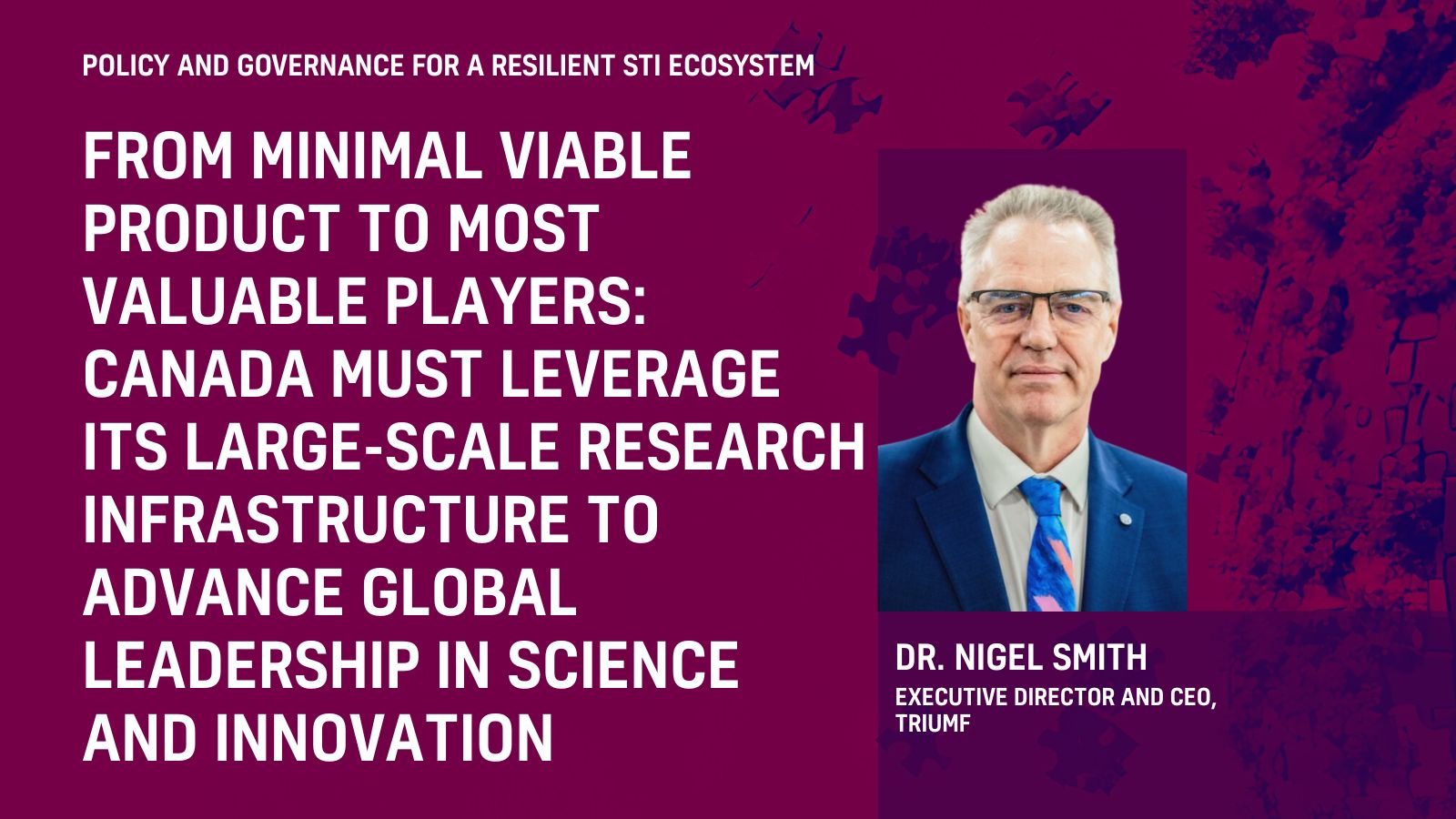From Minimal Viable Product to Most Valuable Players: Canada Must Leverage Its Large-Scale Research Infrastructure to Advance Global Leadership in Science and Innovation

Author(s):
Dr. Nigel Smith
TRIUMF
Executive Director and CEO
Disclaimer: The French version of this text has been auto-translated and has not been approved by the author.
The world today looks strikingly different from even twelve months ago. Geopolitical allegiances are evolving, long-held norms have been disrupted, and nations everywhere are reassessing how they secure their place in an increasingly unpredictable future.
Amid this uncertainty lies an opportunity. For Canada, the opportunity exists to demonstrate that we are more than a dependable partner — we can be a leader. But leadership requires bold decisions, and it requires us to make full use of the strategic advantages we already possess.

Image: TRIUMF’s Meson Hall, home of the world’s largest cyclotron and several experimental facilities, during a July 2025 visit from Honourable Mélanie Joly, Minister of Industry and Minister responsible for Canada Economic Development for Québec Regions, where she announced over $1.3 billion in funding for researchers and projects across Canada.
For Canada to position itself as a global force in this rapidly evolving landscape, we need to leverage every asset at our disposal to build durable, strategic partnerships with international allies. Amongst the strongest of those assets is our network of large-scale research infrastructure, recently dubbed “Major Research Facilities,” or MRFs. These facilities are not simply scientific workhorses; they are engines of innovation, magnets for talent, and platforms for mission-driven research with the power to deliver benefits locally, nationally, and internationally. And yet too often, they are treated as extraneous or liabilities, supported sufficiently to operate but not enough to unleash their full potential.
For decades, Canada’s MRFs have been managed according to a “minimal viable product” mindset. Our funding and policy frameworks have sought to sustain, not to elevate. If we seek global leadership in science and innovation, that approach must change. These facilities are not burdens — they could be translated to our most valuable players.

Image: Minister Joly meets members of the TRIUMF community on top of the cyclotron.
Canada already has everything it needs to succeed: world-class talent, impressive infrastructure, and deep partnerships; however, our approach to MRFs puts us at a disadvantage. In a global arena where boldness is rewarded, hesitancy (or our characteristic Canadian modesty) risks making us invisible. Our approach is currently hampered by a patchwork of ownership, operations, and funding models that are more historical artifact than strategic design. Despite the federal government’s key role in supporting operations, there is no centralized coordination of our MRFs, diluting their ability to contribute to the national mission. The result is diminished impact; while our peers use their laboratories as bargaining chips and flag carriers of national strength, Canada’s world-class facilities are too often overlooked.
The lack of a long-term strategic roadmap compounds the problem. Our reliance on grassroots, proposal-driven processes to define national priorities is ill-suited to the billion-dollar infrastructure we manage. This bottom-up approach fragments effort, encourages short-term thinking, and has resulted in suboptimal programs and activities that cannot easily scale to national objectives. With local and regional interests competing with national goals, the outcome becomes even more clear: Canada needs a new approach to realize the full potential of major research facilities at a global scale.
The competition is intensifying. Across Europe, Asia, and beyond, large-scale research facilities are at the forefront of science, innovation, and diplomacy. These institutions are not just scientific centres; they are national assets strategically positioned as force multipliers for competitiveness and resiliency. Each operate under different models, but they share common traits: centralized organization, long-term vision, an interlinked mission, reliable funding, and accountability at the highest levels of government. The result is clear and impactful: these facilities attract top-tier talent, underpin international collaborations, and serve as visible and tangible proof points of national strength and innovation.

Image: TRIUMF’s world’s-largest cyclotron. TRIUMF’s accelerator and experimental facilities produce over 2 million patient-doses of isotopes and attract over 1000 users and scientific visitors annually.
In the past, Canada has been content to let others lead. But the global environment is shifting. With the realignment of international scientific collaborations, there is space for Canada to step forward. We are trusted, we are respected, and we are well positioned to build the kind of partnerships that deliver both scientific and geopolitical returns. But only if we act decisively, and soon. The window is measured in months, not years.
To seize this opportunity, Canada needs to rethink its approach to MRFs. We must move from viewing them as detached facilities operated at the lowest sustainable cost to recognizing them as multidisciplinary national assets. This requires reaffirming accountability and responsibility for these research assets at the highest levels. It means rethinking operations and funding models for national facilities to align with long-term vision, rather than ad-hoc, grassroots-orientated frameworks designed for individual research projects. These changes do not need substantial new investments. The most important immediate steps are structural and organizational: building the connective tissue that links facilities together, ensures coordination, and embeds them into Canada’s economic and innovation strategies.
There are several viable models already in existence that we can look to for securing this success for Canada. Overall, we need a system that treats Canada’s MRFs not as isolated entities, but as interconnected assets capable of delivering national-scale benefits when coordinated effectively.
This is not just about science; it is about Canada’s future competitiveness and resilience. Investments in agile MRFs create jobs, train the next generation of highly skilled talent, and mitigate risks during times of uncertainty. They amplify Canada’s international profile, attracting partnerships, investment, and opportunity to our doorstep. At a moment when global uncertainty is the new norm, MRFs can be the bedrock of stability and strength that Canada projects to the world.

Image: The Honourable François-Philippe Champagne, Minister of Innovation, Science and Industry, during a visit to TRIUMF’s Isotope Separator and Accelerator facilities in 2023.
But bold decisions must be made soon. High-level stewardship is needed to direct and coordinate Canada’s facilities so they can operate as the most valuable players they truly are. We cannot afford to let an outdated approach cap the potential of billion-dollar assets. And we cannot afford to hesitate while our peers, partners, and competitors move decisively.
Canada’s long-term success depends on strong international networks and allies. Fostering these relationships begin at home. By better leveraging our large-scale research infrastructure, we can deliver greater impact for Canadians, deepen our role in global science, and secure our place as a leader in innovation and discovery. The world is changing quickly. Canada must change with it. The question is not whether we can lead: the question is whether we will choose to. Now is the time to act.

